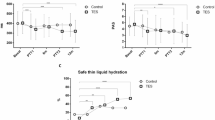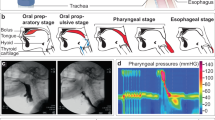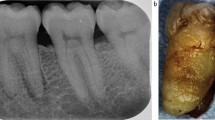Key Points
-
Pharyngeal foreign bodies can present without a positive history and can have a clinical presentation mimicking malignancy.
-
A routine examination of a patient with dysphagia should include eliciting a specifi c history of wearing dentures and examination of teeth.
-
In future designs for dental plates, bridges and crowns the use of a radio opaque material should be considered.
Abstract
Foreign body ingestion in dental and ENT practice is a commonly encountered emergency. In most cases, particularly in adults, there is a definite history of its ingestion, the nature of the foreign body is usually identifiable and the patient almost always presents immediately. We report an unusual case of an elderly patient with a six month history of progressive dysphagia referred to us by the physicians after investigations which were highly suggestive of a hypopharyngeal malignancy. Surprisingly when a biopsy was attempted, the hypopharyngeal mass turned out to be a dental plate. Dentists and otolaryngologists should be aware that pharyngeal foreign bodies can present without a positive history and can have a clinical presentation mimicking malignancy. A history of head injury, dementia, alcohol and drug abuse should be specifically excluded. A routine examination of a patient with dysphagia should include eliciting a specific history of wearing dentures and examination of teeth. In future designs for dental plates, bridges and crowns the use of a radio opaque material should be considered.
Similar content being viewed by others
Log in or create a free account to read this content
Gain free access to this article, as well as selected content from this journal and more on nature.com
or
References
Marais J, Mitchell R, Wightman A J A . The value of radiographic assessment of oropharyngeal foreign bodies. J Laryngol Otol 1995; 109: 452–454.
Nandi P, Ong G B . Foreign body in the oesophagus: review of 2,394 cases. Br J Surg 1978; 65: 5–9.
Abdullah B J J, Teong L K, Mahadevan J, Jalaludin A . Dental prosthesis ingested and impacted in the esophagus and orolaryngopharynx. J Otolaryngol 1998; 27: 190–194.
Hashmi S, Walter J, Smith W, Latis S . Swallowed partial dentures. J R Soc Med 2004; 97: 72–75.
Chandler H H, Bowen R L, Paffenbarger G C . Development of a radio-opaque denture base material. J Biomed Mater Res 1971; 5: 253–265.
Tsao D H, Guilford H J, Kazanoglu A, Bell D H . Clinical evaluation of a radio-opaque denture base resin. J Prosthet Dent 1984; 51: 456–458.
Davy K W, Causton B E . Radio-opaque denture base: a new acrylic polymer. J Dent 1982; 10: 254–264.
Loh L E, Chee S G . Barium swallow: Its role in the management of an oesophageal F B. Singapore Med J 1988; 29: 438–440.
Braverman I, Gomori J M, Polv O, Saah D . The role of CT imaging in the evaluation of cervical esophageal foreign bodies. J Otolaryngol 1993; 22: 311–314.
Author information
Authors and Affiliations
Corresponding author
Additional information
Refereed paper
Rights and permissions
About this article
Cite this article
Rana, I., Syed, M., Adams, C. et al. Hypopharyngeal foreign body masquerading as malignancy. Br Dent J 207, 361–362 (2009). https://doi.org/10.1038/sj.bdj.2009.903
Accepted:
Published:
Issue date:
DOI: https://doi.org/10.1038/sj.bdj.2009.903



